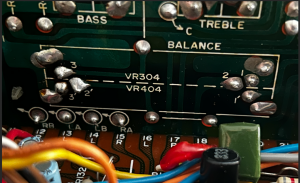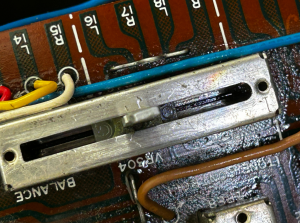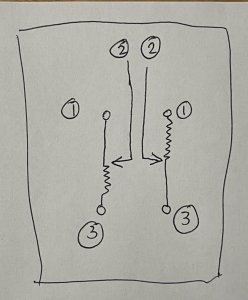well, if you plan to bypass the existing sliders, bear in mind that the aforementioned is true but only if you take the existing slider out of circuit. You can't just tie into the existing solder pads with the current slider still there or else the bypass won't work properly. That is because while you think you are adding a 20k ohm resistor, the boombox thinks that resistor is actually a 10k ohm resistor due to the parallel path from the existing slider resistor. Furthermore, if the balance slider contacts (feelers) aren't completely detached and gone, they might be causing other issues internally.
you can remove the slider from circuit in a few ways:
You can cut the traces from the slider from beneath or
You can remove the existing slider completely which is probably going to be ugly
You can remove the existing slider, disassemble it and remove the internal contacts, then cut the resistor traces rendering it a dummy slider
You can remove the existing slider, trim off the leads from beneath leaving the housing legs to re-secure the slider but which renders it a dummy slider
You can desolder the slider from beneath (only the 1/2/3 leads, not the slider housing) and confirm that none of the leads are touching the pads.
And lastly, you can cut the traces from below to sever the traces, this being the last choice.
Honestly, to get to the bottom of the slider board to desolder or work on it, it is a lot of work and in my opinion, if you get that far, you might as well repair that slider properly. To remove the tone board, you will need to first desolder the entire row of solder pads that secure that board to the main board. If you try to work on that slider board with it connected to the main board, you will most likely end up damaging the traces and pads causing them to detach from the substrate.
If you are able to remove the balance slider, and you are willing to mail it to the USA, I can rebuild that slider for you for $20. Or if you wish to mail the entire board here, I can rebuild and recap the entire board for $79. You must pay shipping both ways and be forewarned that USA shipping costs are the highest in the world.






